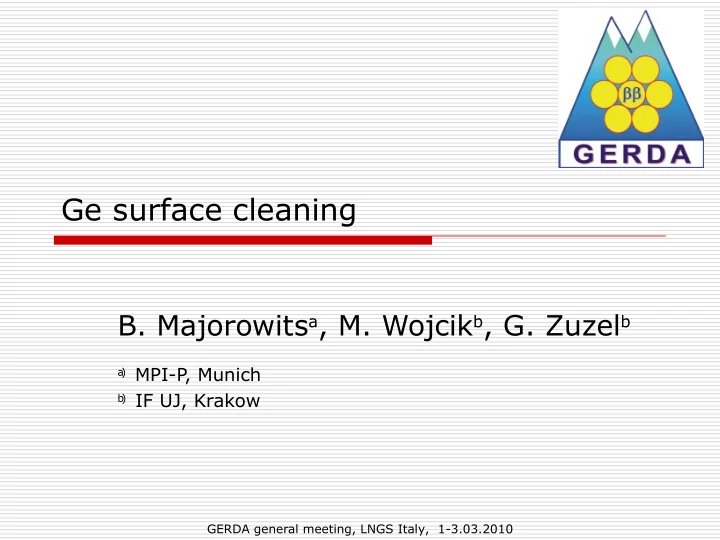

Ge surface cleaning B. Majorowits a , M. Wojcik b , G. Zuzel b ) MPI-P , Munich a ) IF UJ, Krakow b GERDA general meeting, LNGS Italy, 1-3.03.2010
Outlook Applied technique for Ge cleaning - Loading samples with the Rn daughters - Investigations of 210 Pb/ 210 Bi/ 210 Po Ge surface treatment - Optical quality Ge - HPGe - Comparison with Copper and Steel Summary GERDA general meeting, LNGS Italy, 1-3.03.2010
Loading the samples Discs Filter 222 Rn source (1.4 MBq) Pump GERDA general meeting, LNGS Italy, 1-3.03.2010
0 Pb/ 2 0 Bi/ 2 0 Po Measuring 2 1 1 1 Screening of 210 Po with an alpha spectrometer 50 mm Si-detector, bcg ~ 2 α /d (1-10 MeV) sensitivity ~ 20 mBq/m 2 (100 mBq/kg, 210 Po) Screening of 210 Bi with a beta spectrometer 2 × 50 mm Si(Li)-detectors, bcg ~ 0.18/0.40 cpm sensitivity ~ 10 Bq/kg ( 210 Bi) Screening of 210 Pb (46.6 keV line) with a gamma spectrometer 16 % - HPGe detector with an active and a passive shield GERDA general meeting, LNGS Italy, 1-3.03.2010
Optical quality Germanium “Test run” before using HPGe Samples cut out from bigger Ge pieces, no special surface treatment after cutting 2 discs 50 mm in diameter and 3 mm thick were exposed for 7 months to our Rn source (1.4 MBq) Discs etched by Canberra according to their standard procedure applied to HPGe crystals Discs before/after etching were screened for 210 Pb/ 210 Bi/ 210 Pb GERDA general meeting, LNGS Italy, 1-3.03.2010
Optical quality Germanium - results Disc No. 1 Isotope Disc Initial activity Activity after Reduction Average Remarks side [cpm] cleaning [cpm] factor R reduction factor R a v 0 Pb a 2.08 < 0.02 > 104 > 104 Amount of removed Ge not 2 1 measured. After etching side 0 Pb. b 3.43 - - b not measured for 2 1 0 Bi a 42.7 < 0.18 > 237 > 427 2 1 b 67.9 < 0.11 > 617 0 Po a 42.4 0.04 1060 2300 2 1 b 71.7 0.02 3585 GERDA general meeting, LNGS Italy, 1-3.03.2010
Optical quality Germanium - results Disc No. 2 Isotope Disc Initial Activity Reduction Average Remarks side activity after cleaning factor R reduction [cpm] [cpm] factor R a v 0 Pb a 2.09 - - > 106 Amount of removed Ge not 2 1 measured. After etching side 0 Pb. 2 0 Bi b 2.12 < 0.02 > 106 a not measured for 2 1 1 not measured because it has 0 Bi a 40.7 - - - 2 1 decayed. b 46.1 - - 0 Po a 50.0 0.06 820 880 2 1 b 47.0 0.05 940 Activities of all isotopes reduced significantly after etching, 0 Po removed most efficiently 2 1 GERDA general meeting, LNGS Italy, 1-3.03.2010
HPGe Two 50 mm in diameter and 3 mm thick HPGe discs provided by MPI-M One disc and HP water (2 L) exposed to the strong Rn source for 9 months Exposed disc etched by Canberra in their standard solution, clean disc etched in a solution made with the exposed water Discs before/after etching screened for 210 Pb/ 210 Bi/ 210 Pb GERDA general meeting, LNGS Italy, 1-3.03.2010
HPGe discs loading Drying column (Si-Geel) Ge discs Filter HP Water 222 Rn source (1.4 MBq) Pump GERDA general meeting, LNGS Italy, 1-3.03.2010
HPGe results Exposed disc 0 Po 0 Bi 0 Pb 2 1 2 1 2 1 Before cleaning 11.88 ± 0.19 14.70 ± 0.12 0.717 ± 0.011 After cleaning 0.102 ± 0.006 0.017 ± 0.008 < 0.001 Reduction factor 117 ± 7 865 ± 407 > 717 Unexposed disc 0 Po 0 Bi 0 Pb 2 1 2 1 2 1 Before etching (background) 0.064 ± 0.005 0.111 ± 0.004 0.0163 ± 0.0004 After etching (average act. from 0.023 ± 0.007 0.106 ± 0.011 0.0066 ± 0.0016 both disc sides) bcg corrected! Increase above the background ~ 35 % ~ 100 % ~ 40 % Exposed water measured with an HPGe spectrometer did not show any activity above the background (LLL in HD). GERDA general meeting, LNGS Italy, 1-3.03.2010
Comparison between Cu/Steel/Ge Isotope Average reduction factors for etching Copper Steel Ge (Opt. – HP) 0 Pb ~ 50 ~ 100 100 – 700 2 1 0 Bi ~ 50 ~ 100 400 – 800 2 1 0 Po ~ 1 ~ 20 1000 – 100 2 1 Etching of Copper is the less effective, for Po there is no effect Results for Steel are acceptable, also Po has been removed Etching of Ge is the most efficient, surface quality seems to play a role GERDA general meeting, LNGS Italy, 1-3.03.2010
Summary Etching of opt. Ge/HPGe removes efficiently all long-lived Rn daughters Small quantities of 210 Pb/ 210 Bi/ 210 Pb found on the surface of the unexposed disc etched in the contaminated solution (the level of water contamination was unknown) - for each sample a fresh solution is required in order to avoid re- depositon 210 Po removed more efficient form optical quality Ge, 210 Pb/ 210 Bi from HPGe – surface quality plays a role Etching effectiveness in 210 Pb/ 210 Bi/ 210 Po removal differs for each isotope and for different materials (Cu, Steel, Ge) GERDA general meeting, LNGS Italy, 1-3.03.2010
Recommend
More recommend